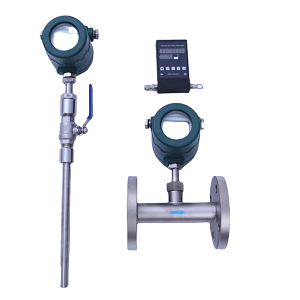Like the Coriolis flow meter, thermal flow meters measure mass flow, but the technology is not the same. Rather than utilizing fluid momentum,
thermal mass gas flow meters use the thermal conducting properties of gas.
Thermal gas mass flow meter measure the temperature distinction between a heated sensor and the ambient flow stream. The mass flow rate sensor regularly needs one or more temperature sensors to detect the gas or air temperature at specific points.
Industrial thermal dispersion flow meters utilize a concept similar to hot wire anemometers. The little, delicate anemometers are used in velocity profile and turbulence research and are susceptible to breakage and to contamination from dirt. Conversely, the
industrial thermal mass air flow meters use rugged RTD temperature sensors that are better adjusted to industrial environments while still measuring the speed of heat dissipation to determine mass flow of gas or air.
Thermal flow meters’ advantage is from their competitive low price cost together with their ability to detect low-pressure gases that are
Coreolis type flow meter cannot measure. One obviously advantage is that the thermal meter does not need external temperature and pressure correction to directly get mass flow of gas.
While thermal dispersion flow meter can uniquely take measurement many gas or air flow measurement applications, such as natural gas,
biogas flow meter,
compressed air flow meter ,flare air, nitrogen, helium (He),including process gas and other non-custody transfer applications, but they cannot measure liquid or steam flow measurement.
 Thermal mass flow meter for lab gas2019/08/08SRK-M Micro-flowrate Thermal gas mass flow meter is designed on the basis of thermal dispersion, and adopts method of constant differential temperature to measuring gas flow. It does not require exter...VIEW
Thermal mass flow meter for lab gas2019/08/08SRK-M Micro-flowrate Thermal gas mass flow meter is designed on the basis of thermal dispersion, and adopts method of constant differential temperature to measuring gas flow. It does not require exter...VIEW Thermal mass flow meter for corrosive gas2019/07/18Thermal mass flow meter with PTFE painting probe or ceramic probe is suitable for most gas flow rate measurement, especially suitable for aggressive or caustic gases, such as emission gas,HF gas, ammo...VIEW
Thermal mass flow meter for corrosive gas2019/07/18Thermal mass flow meter with PTFE painting probe or ceramic probe is suitable for most gas flow rate measurement, especially suitable for aggressive or caustic gases, such as emission gas,HF gas, ammo...VIEW In-line type thermal dispersion flow meter2019/06/14Gas mass flow measurement.
In-line type thermal dispersion flow meter2019/06/14Gas mass flow measurement. Thermal mass flow meter2019/06/14Low cost flow meter for gas and air
Thermal mass flow meter2019/06/14Low cost flow meter for gas and air Bent tube Coriolis flow meter2019/07/22Smaller installation size.
Bent tube Coriolis flow meter2019/07/22Smaller installation size. Coriolis mass flow meter2019/06/12Best accuracy flow meter
Coriolis mass flow meter2019/06/12Best accuracy flow meter